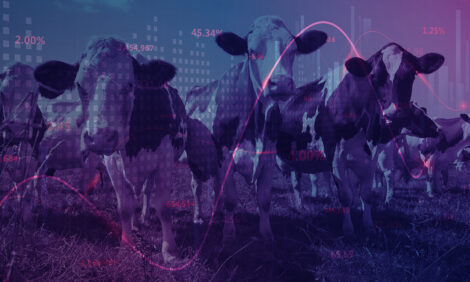



Selecting the Right Dairy For Your Farm: Herring-bones versus Rotaries
Choosing the type of milking facility to have on farm affects profit margins and labour efficiency making it a huge decision, say Dairy New Zealand who consider the two most common designs.The Story so Far
Farmers in two of the traditional power house regions of dairying
can take the credit for introducing the two dairy types that have
dominated the New Zealand dairy industry for over 30 years.
First, in 1952, Waikato farmer Ron Sharp developed his version
of the herringbone1, which was quickly adopted by farmers and
by the mid-1980s more than 80 percent of all herds were milked
using this type of dairy (Figure 1).
The second development came 17 years later, when in 1969 Merv
Hicks, a Taranaki farmer, constructed the first rotary abreast dairy
(more commonly known as the external rotary) in New Zealand2.
In contrast, the adoption of the rotary has been slower, likely
due to the durability of the herringbone, the early rotary’s higher
capital and maintenance costs, and its lack of labour saving
without automation (as a cups-off operator was required).
As the dairy industry has grown, investment in rotary dairies has
accelerated, led mainly by operators of large herds. Between
1998 and 2008, 72 percent of new dairy installations were
rotaries, up from 52 percent in the previous decade3. The average
herd size for farms with rotaries is approximately 625, compared
with 326 for herringbones4.
Figure 2 shows that for herds larger than 500 cows, the rotary
becomes the dairy of choice. Today, 23.6 percent of herds are
milked through rotaries; the most common are between 50 and
60 bails (Figure 3).
The remainder of herds are milked in swing-over herringbones.
Other dairy types, such as double-up herringbones, a few
remaining walk-throughs and the first handful of fully automated
robotic milking systems are in use, but these make up fewer than
1.5 percent of all dairies.


Milking Potential

The herringbone and rotary dairy differ in design but how do they
differ in their ability to milk cows?
The data presented in Figure 4 (pg 10) are from two sources:
recent data manually entered by farmers on the Milksmart
website (milksmart.co.nz) and electronic data obtained in the
2010/11 season from 80 high tech rotary dairies5,6. The number
of cows milked per hour increases as the number of clusters
increases (i.e. the larger the shed, the more cows per hour
that can be milked). Looking at the Milksmart data, 40-aside
herringbones and 40-bail rotaries, on average, achieved a similar
number of cows milked per hour.
Accounting for the labour required to operate the dairy, the
advantage of the larger dairies was reduced. The most labour
efficient was the 60-bail rotary with automatic cluster removers
(ACR) and, therefore, no cups-off operator.

Economics
Modern rotary dairies are more efficient at milking cows
but how do they compare as an investment? To answer this
question, two scenarios were considered.
Scenario 1
This represented a farm with 450 cows building a new dairy.
The analysis compared investment in a 40-aside herringbone
operated by two people, with a 44-bail rotary including
sufficient automation to be operated by a single operator (i.e.
ACR, auto teat sprayer).
Both options had automatic drafting. Production and farm
working expenses were calculated based on an analysis of the
average 2010/11 Waikato farm7. Other assumptions included:
milk price at $6.50/kg MS, twice daily milking, interest
calculated at 7 percent, plant and machinery depreciated over
12.5 years, buildings and yards over 25 years.
Herd milking duration was calculated based on a 9 minute row
or round and it was assumed that two operators were required
for the herringbone and a single operator for the rotary. Labour
to fetch herds and assist with other tasks associated with
milking were the same for both farms.

The total labour saving was accounted for in the model using a
rate of $25/hour, which included an accommodation allowance.
Scenario 2
This represented a 1000 cow dairy conversion with income
and farm working expense data based on the average 2010/11
Canterbury-Marlborough farm7. Four options were considered:
40-aside herringbone, 50, 60 or 80-bail rotary.
It was assumed that two operators were required for the
herringbone and the 80-bail rotary, and a single operator for the
smaller 50 and 60-bail rotaries. All other assumptions were the
same as for scenario one.
Economic Analysis for Two Case Studies: (1) 450 Cows Comparing 40-aside Herringbone and 44-bail Rotary (2) 1000 Cows Comparing 40-aside Herringbone and 50, 60 or 80-bail Rotary.

¥ Full time equivalents from 2010/11 Economic Farm Survey7 adjusted to account for the labour saving due to the milking system.
# Includes excavation, power supply lines, building and yards, effluent line to pond, leg spreaders (rotary only), water pumps, reticulation, water tank/s, electrical, vat wash (single vat), dung buster and cleaning channel, hot water cylinders, milk cooling.
‡ Year 1, only liabilities are those borrowed for the new dairy.
** Over 25 years.
Pros and cons
Advantages and disadvantages of herringbone dairies8
Advantages
- Cheaper to build and maintain
- Highest cows per cluster per hour rate – cows exit and enter while other side is milking
- Cows are in full view of the milker while in the dairy
- Easier to drench
- Can increase capacity (by lengthening the pit if starting from a small dairy size)
- More sociable.
Disadvantages
- Requires a lot of walking and swivelling for milkers
- An efficient milking routine is important to achieve maximum throughput
- Installation of automatic cup removers (ACR) can be complicated; can complicate the milking routine; and may not offer any efficiency advantages
- Loading and unloading can be slow in large herringbones
- Slower milking cows can slow down the whole row if MaxT (milksmart.co.nz) is not used
- In-shed feeding system not as simple as for a rotary.
Advantages and disadvantages of rotary dairies8
Advantages
- Quick entry and exit times, if working well
- Cow flow less affected by cow/people interactions
- Usually a low milk line, so lower vacuum
- Little walking required of the milker
- Slower milking cows do not hold up more than one set of cups
- Platform speed can be varied with the stage of lactation and yield of the herd
- Automation often easier to install
- Generally brighter and airy working environment.
Disadvantages
- Expensive to build
- Difficult to expand
- Without automation, it requires at least two milkers
- Awkward for drenching
- Difficult for the milkers to see the cows for at least some of the milking
- Cows frequently milked out before they get to the cluster removal station (only an issue if no ACR)
- More moving parts than a herringbone, requiring more maintenance.
References
- Agricultural innovation in the Waikato [Online]. Available at http://www. agheritage.co.nz/innovation
- Eltham man turns milking around [Online]. Available at http://www. pukeariki.com/Research/TaranakiResearchCentre/TaranakiStories/ TaranakiStory/id/464/title/eltham-man-turns-milking-around.aspx
- Cuthbert S. 2008. DairyNZ milking practices and technology use survey. Report prepared for DairyNZ, Hamilton, New Zealand. pp 40.
- Data sourced from LIC, 8th October 2012.
- Jago J., Edwards P., Burke J., and Scott S. 2011. Milking effectively in Rotary Dairies. Proceedings of the South Island Dairy Event (SIDE), 27-29 June, Lincoln University, 288-298 http://side.org.nz/Papers/2011/Milksmart%20 What%20makes%20a%20farm%20dairy%20efficient
- Edwards P., Jago J. and Lopez-Villalobos N. 2012. Increasing the percentage of cows completing a second rotation improves throughput in rotary dairies. Animal Production Science. http://dx.doi.org/10.1071/AN12071
- DairyNZ. 2012. DairyNZ Economic Farm Survey 2010-11 [Online]. Available at http://resources.dairynz.co.nz/DownloadResource.aspx?id=719
- New Dairy Design [Online]. Available at http://www.milksmart.co.nz/ NewDairyShed
January 2013


